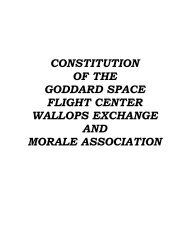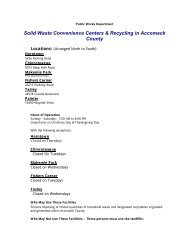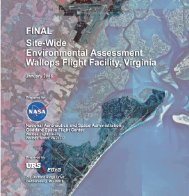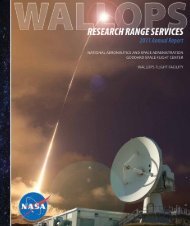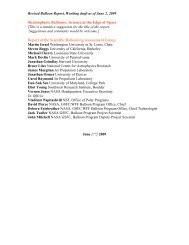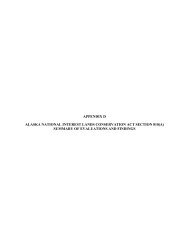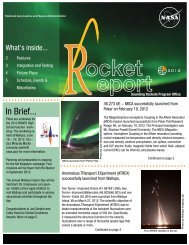WFF Frequency Utilization Management Handbook - Wallops Flight ...
WFF Frequency Utilization Management Handbook - Wallops Flight ...
WFF Frequency Utilization Management Handbook - Wallops Flight ...
Create successful ePaper yourself
Turn your PDF publications into a flip-book with our unique Google optimized e-Paper software.
12. Receiver Data<br />
A. Nomenclature: Manufacturer, model, military designation, etc.<br />
800-HDBK-0001B<br />
22 of 31<br />
B. Location: Physical description of transmitter location, e.g., north end of <strong>Wallops</strong><br />
Island, building V-25.<br />
C. Stability: Local oscillator stability in percentage of tuned frequency.<br />
D. Sensitivity: Expressed in microvolt or dBm.<br />
E. Antenna Type: Give type and size if relevant, e.g., 36-foot dish.<br />
F. Antenna Polarization: Self-explanatory.<br />
G. Antenna Gain: Self-explanatory.<br />
H. Antenna, Fixed or Rotatable: Self-explanatory.<br />
I. Antenna, Beam Width – AZ: Self-explanatory.<br />
J. Antenna, Beam Width – EL: Self-explanatory.<br />
K. Fixed antenna Direction or Pattern: Provide AZ-EL angles.<br />
L. Antenna Latitude and Longitude: Self-explanatory.<br />
13. Has NTIA or FCC already assigned frequency to organization for area in which it<br />
will be used? Yes or No. If Yes, provide NTIA serial number or FCC license number.<br />
14. Miscellaneous Comments: Self-explanatory.<br />
Check the <strong>Wallops</strong> Documentation Web site at<br />
http://www.wff.nasa.gov to verify this is the correct version prior to use.



